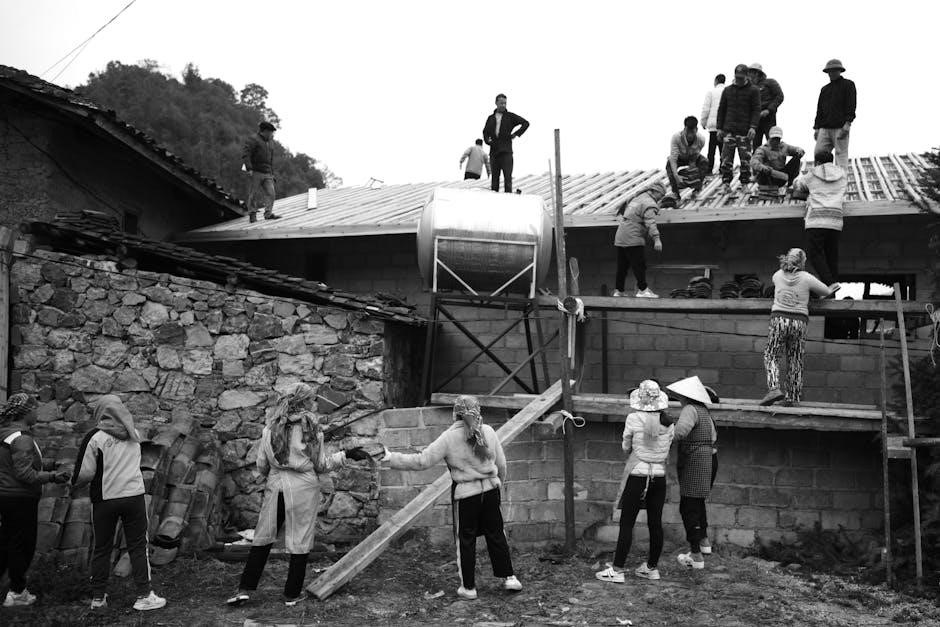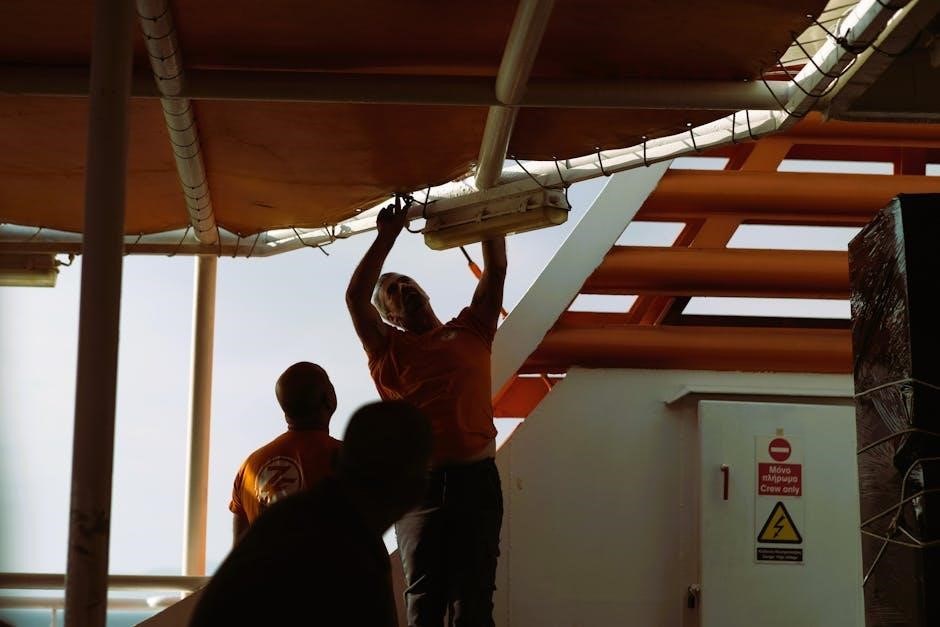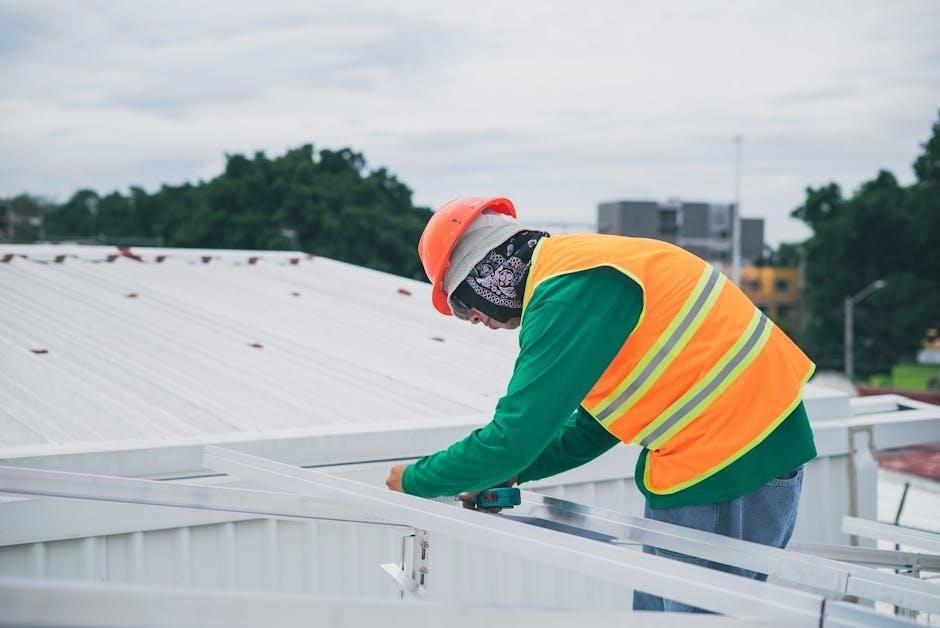nrca roofing manual
The NRCA Roofing Manual is a premier technical publication offering comprehensive guidelines on roofing design‚ materials‚ and installation‚ updated annually to reflect industry advancements and best practices.
1.1 Overview of the NRCA Roofing Manual
The NRCA Roofing Manual is a comprehensive resource providing detailed guidelines for roofing professionals. It covers design‚ materials‚ and installation techniques for steep-slope and low-slope systems. The 2025 edition includes updated best practices‚ material specifications‚ and safety protocols. Designed for contractors‚ architects‚ and builders‚ the manual ensures compliance with industry standards. It addresses waterproofing‚ insulation‚ and sustainable practices‚ offering practical solutions for various roofing projects. Available in digital and print formats‚ the manual is accessible to NRCA members and can be purchased by non-members‚ making it an essential tool for staying updated on roofing advancements.
1.2 Importance of the NRCA Roofing Manual in the Industry
The NRCA Roofing Manual is a cornerstone of the roofing industry‚ providing standardized guidelines that ensure high-quality installations and compliance with best practices. It serves as a primary reference for contractors‚ architects‚ and builders‚ offering detailed insights into design‚ materials‚ and techniques. By adhering to the manual‚ professionals can enhance safety‚ durability‚ and efficiency in roofing projects. Its annual updates reflect the latest advancements‚ making it an indispensable tool for staying current with industry developments. The manual also supports professional development by aligning with certification programs‚ fostering expertise and excellence across the roofing workforce.
1.3 History and Evolution of the NRCA Roofing Manual
The NRCA Roofing Manual has a rich history dating back to its first publication in the 1950s‚ initially focusing on asphalt-based roofing systems. Over the decades‚ it has evolved to address advancements in materials‚ technologies‚ and industry standards. The manual has expanded to cover steep- and low-slope roofing‚ waterproofing‚ and sustainable practices‚ reflecting the industry’s growth. Annual updates ensure it remains relevant‚ incorporating feedback from professionals and new research. This continuous improvement has solidified its role as a trusted resource‚ shaping roofing practices and safety standards across North America.

Steep-Slope Roof Systems
Steep-slope roofs‚ typically found in residential and architectural designs‚ feature inclined surfaces to shed water effectively. The NRCA manual provides design‚ material‚ and installation guidance for these systems‚ ensuring durability and performance while addressing safety and aesthetic considerations.
2.1 Design Considerations for Steep-Slope Roofs
Designing steep-slope roofs requires careful consideration of roof pitch‚ load calculations‚ and drainage systems. The NRCA Roofing Manual emphasizes the importance of ensuring structural integrity and water shedding. Roof pitch‚ measured in rise over run‚ must be adequate to prevent water ponding and ensure material performance. Designers must also account for local building codes‚ climate conditions‚ and aesthetic preferences. Proper load calculations are critical to withstand snow‚ wind‚ and other environmental stresses. Additionally‚ drainage design must prioritize efficient water flow to avoid damage and prolong roof lifespan. Balancing functionality and design is key for steep-slope roofing systems.
2.2 Material Selection for Steep-Slope Roofing
Material selection for steep-slope roofing is critical for durability and performance. The NRCA Roofing Manual recommends considering factors like climate‚ budget‚ and desired appearance. Asphalt shingles are the most common choice due to their affordability and ease of installation. Metal roofing offers longevity and fire resistance but may require specialized labor. Clay and concrete tiles provide excellent weather resistance but are heavier and more expensive. Slate is durable but requires robust structural support. Wood shakes and shingles offer a natural aesthetic but require regular maintenance. Each material has unique benefits and challenges‚ so selecting the right one ensures optimal roof performance and satisfaction.
2.3 Installation Techniques for Steep-Slope Roofs
Proper installation is essential for steep-slope roofs to ensure durability and weather tightness. The NRCA Roofing Manual emphasizes starting with a well-prepared deck and applying a high-quality underlayment. Starter courses are critical to prevent wind-driven water infiltration. Shingles or shakes should be installed with precise fastening patterns and spacing to avoid buckling or gaps. Ventilation must be ensured to prevent moisture buildup. Safety measures‚ such as secure ladder placement and fall protection‚ are non-negotiable. Adhering to manufacturer guidelines ensures optimal performance and longevity of the roofing system.
Low-Slope Roof Systems
Low-slope roofs require careful design and material selection to ensure durability and weather resistance. The NRCA Roofing Manual provides detailed guidelines for installation and maintenance.
3.1 Design and Material Guidelines for Low-Slope Roofs
Low-slope roofs require careful design to ensure proper drainage and structural integrity. The NRCA Roofing Manual outlines guidelines for slope ratios‚ drainage systems‚ and material compatibility. Key considerations include load-bearing capacity‚ weather resistance‚ and thermal expansion. Recommended materials like EPDM‚ PVC‚ and TPO are highlighted for their durability and waterproofing properties. The manual also emphasizes the importance of insulation compatibility and proper fastening systems to prevent leaks and structural damage. Adhering to these guidelines ensures optimal performance and longevity of low-slope roofing systems.
- Material Selection: Choose materials based on climate‚ budget‚ and building requirements.
- Drainage Design: Ensure adequate slope and drainage pathways to prevent water pooling.
- Structural Integrity: Verify that the roof can support the weight of materials and additional components.
3.2 Installation Best Practices for Low-Slope Roofing
The NRCA Roofing Manual provides detailed installation guidelines for low-slope roofs to ensure durability and performance. Surface preparation is critical‚ requiring a clean‚ dry‚ and even substrate. Material securement methods‚ such as fastening patterns and adhesive applications‚ must align with manufacturer specifications. Proper membrane alignment and seaming techniques are emphasized to prevent leaks. Additionally‚ insulation installation should be precise to maintain thermal performance. Regular quality control inspections are recommended to identify and address issues promptly‚ ensuring compliance with industry standards and extending the roof’s lifespan.
- Follow manufacturer guidelines for specific materials like EPDM or PVC.
- Ensure proper fastening to prevent uplift and membrane damage.
- Conduct post-installation inspections to verify system integrity.
3.3 Maintenance and Repair of Low-Slope Roofs
Regular maintenance is vital for extending the lifespan of low-slope roofs. The NRCA Roofing Manual recommends routine inspections to identify and address issues like cracks‚ punctures‚ and loose seams. Timely repairs using compatible materials prevent minor damage from escalating. Drainage systems should be cleaned regularly to ensure proper water flow. Additionally‚ protective coatings can be applied to enhance durability. Documenting maintenance activities helps track the roof’s condition and plan future inspections. Proper care ensures the roof remains watertight and functional‚ reducing long-term costs and potential for premature replacement.
- Inspect roofs seasonally to catch issues early.
- Use compatible materials for repairs to maintain system integrity.
- Clean drainage systems to prevent water pooling and damage.

Waterproofing and Roofing Interrelation
Waterproofing and roofing are closely linked‚ ensuring buildings are protected from water infiltration. Proper techniques and compatible materials ensure a durable‚ watertight system. Regular inspections and maintenance are critical to prevent leaks and damage. The NRCA Roofing Manual emphasizes the importance of integrating waterproofing measures into roofing designs for long-term performance and structural integrity.
Key considerations include material compatibility and installation precision.
4.1 General Waterproofing Project Considerations
Waterproofing projects require thorough planning and assessment to ensure effectiveness. Surface preparation‚ material compatibility‚ and environmental factors like weather and drainage must be considered. Compliance with industry standards and best practices is essential. Proper substrate condition and drainage design prevent water accumulation. Material selection should align with the project’s specific needs and environmental conditions. Regular inspections and maintenance are crucial to sustain performance. Integrating waterproofing with roofing systems enhances overall building protection. Documentation and collaboration among stakeholders ensure successful execution and long-term durability.
Attention to detail and adherence to guidelines are paramount for optimal results.
4.2 Best Practices for Waterproofing in Roofing Systems
Effective waterproofing in roofing systems begins with proper material selection and surface preparation. Ensure all surfaces are clean‚ dry‚ and free of contaminants before application. Follow manufacturer guidelines for product compatibility and installation. Design systems to promote drainage‚ avoiding ponding water. Regular inspections and maintenance are critical to identify and address potential issues early. Trained professionals should perform installations to guarantee a durable‚ watertight seal. Documenting processes and maintaining records enhances accountability and long-term performance. Adhering to these best practices minimizes leaks‚ extends system lifespan‚ and ensures structural integrity.
Proper execution and ongoing care are vital for optimal waterproofing outcomes.
4.3 Integration of Waterproofing Materials in Roof Design
Integrating waterproofing materials into roof design requires careful consideration of compatibility and functionality. Choose materials that align with the roof’s slope‚ drainage patterns‚ and structural load; Ensure waterproofing layers are installed between roofing components for optimal protection. Follow manufacturer guidelines for compatibility and application. Enhance design with drainage features like gutters and downspouts. Incorporate flashing details at critical points to prevent water infiltration. Regular inspections and maintenance are essential to prevent material degradation. Advanced materials‚ such as liquid-applied membranes‚ offer enhanced durability. Collaborate with professionals to ensure designs meet performance standards. Proper integration ensures a watertight‚ long-lasting roofing system.
Effective integration enhances durability and weather resistance.

Roofing Materials and Their Applications
Roofing materials vary widely‚ from asphalt shingles to metal‚ clay tiles‚ slate‚ and SPF systems. Each material offers unique benefits‚ catering to specific design and functional needs.
5.1 Asphalt-Based Roofing Materials
Asphalt-based roofing materials are widely used due to their affordability‚ durability‚ and ease of installation. Asphalt shingles are the most common type‚ offering versatility in color and style to suit various architectural designs. They provide excellent weather resistance and are suitable for steep-slope roofs. Modified bitumen membranes are another asphalt-based option‚ ideal for low-slope applications‚ offering enhanced durability and UV resistance. These materials are also compatible with insulation systems‚ ensuring energy efficiency. Their adaptability‚ combined with adherence to industry standards‚ makes them a preferred choice for both residential and commercial roofing projects.

5.2 Metal Roofing Systems and Their Benefits
Metal roofing systems are renowned for their durability‚ longevity‚ and aesthetic appeal. They offer exceptional resistance to weathering‚ including heavy rain‚ hail‚ and extreme temperatures. Metal roofs are fire-resistant and can last 30-50 years or more with proper maintenance. Available in various materials like galvanized steel‚ aluminum‚ and copper‚ they cater to different budgets and architectural styles. Their lightweight design reduces structural stress‚ and they are low-maintenance‚ resisting rot and insect damage. Additionally‚ metal roofs can be energy-efficient‚ with reflective coatings reducing heat absorption‚ making them an eco-friendly choice for modern roofing needs.
5.3 SPF (Spray Polyurethane Foam) Roofing Systems
SPF roofing systems are a popular choice for their versatility and efficiency. Applied as a liquid‚ they expand into a solid foam‚ creating a seamless and durable barrier against weather elements. Known for their excellent insulation properties‚ SPF roofs can significantly reduce energy consumption. They are also lightweight‚ making them suitable for structures that cannot support heavier materials. Additionally‚ SPF can be applied over existing roofs‚ eliminating the need for costly tear-offs. Their long lifespan and low maintenance requirements make them a cost-effective and environmentally friendly option for both new constructions and renovations.
Construction Details and Guidelines
Construction details are critical for ensuring roof durability and functionality‚ covering flashing‚ drainage‚ insulation‚ and ventilation. Proper execution prevents leaks and structural issues‚ adhering to industry standards.
6.1 Flashing and Drainage Details
Flashing and drainage are critical components of roofing systems‚ ensuring water tightness and structural integrity. The NRCA Roofing Manual emphasizes proper flashing installation at penetrations‚ valleys‚ and eaves to prevent leaks. Drainage details‚ such as gutters and downspouts‚ must be designed to handle water volume efficiently. Materials like metals or PVC are commonly used for flashing‚ with sealing methods tailored to specific roof types. Improper installation can lead to water infiltration and damage. Regular inspections and maintenance are essential to maintain functionality and extend roof lifespan. Adhering to these guidelines ensures reliable performance and protects against weather-related risks.

6.2 Insulation and Ventilation Requirements
Insulation and ventilation are essential for energy efficiency and roof longevity. The NRCA Roofing Manual outlines requirements for thermal insulation materials‚ such as rigid foam or fiberglass‚ to meet energy codes. Ventilation systems‚ including ridge vents and soffit vents‚ ensure airflow to prevent moisture buildup. Proper insulation reduces heat transfer‚ lowering energy costs‚ while balanced ventilation prevents condensation and structural damage. Climate-specific recommendations guide material selection and installation. Adherence to these standards ensures optimal performance‚ durability‚ and compliance with building codes‚ creating a stable and energy-efficient roofing system. Regular inspections are crucial to maintain these critical components effectively.
6.3 Skylight and Curb Installation Guidelines
Skylights and curbs require precise installation to ensure watertightness and structural integrity. The NRCA Roofing Manual provides detailed guidelines for skylight placement‚ curb construction‚ and flashing details. Curbs must be properly sized and aligned with the roof deck‚ while skylights should be sealed to prevent water infiltration. Flashing materials and techniques are emphasized to maintain roof system performance. Regular inspections and maintenance are recommended to ensure long-term functionality. Compliance with local building codes and manufacturer specifications is essential for safe and durable installations‚ enhancing both aesthetics and functionality of the roofing system effectively.

Safety Standards and Practices
The NRCA Roofing Manual emphasizes adherence to OSHA regulations‚ proper use of PPE‚ and hazard identification to ensure safe roofing operations and protect workers effectively always.

7.1 Safety Protocols for Roofing Contractors
The NRCA Roofing Manual outlines essential safety protocols for contractors‚ emphasizing hazard assessments‚ proper equipment usage‚ and adherence to OSHA standards. Contractors must conduct regular safety training‚ ensuring all crew members understand fall protection measures and emergency procedures. Site-specific safety plans should be developed‚ and supervisors must enforce compliance. Proper personal protective equipment (PPE) is mandatory‚ and equipment must be regularly inspected. Contractors are also required to maintain first aid kits and ensure emergency response plans are in place. Compliance with these protocols minimizes risks‚ protects workers‚ and ensures a safe roofing environment.
7.2 Fall Protection and PPE Requirements
Fall protection and PPE are critical for roofing contractors to ensure worker safety. The NRCA Roofing Manual mandates the use of fall protection systems‚ including harnesses‚ lanyards‚ and anchor points‚ when working at heights above 6 feet. Hard hats‚ safety glasses‚ gloves‚ and steel-toe boots are essential PPE. Contractors must ensure all equipment meets OSHA standards and is properly maintained. Regular inspections of fall protection gear are required‚ and workers must be trained in its correct use. Compliance with these requirements significantly reduces the risk of accidents and injuries on roofing sites.
7.3 Emergency Procedures and First Aid
Emergency procedures and first aid are vital for ensuring prompt responses to roofing site incidents. The NRCA Roofing Manual emphasizes having a comprehensive emergency response plan‚ including evacuation routes and first aid kits. Workers should be trained in basic first aid‚ such as wound cleaning‚ bleeding control‚ and CPR. In case of falls‚ immediate medical attention is crucial. For cuts or abrasions‚ proper wound care prevents infection. Fire extinguishers and emergency contact lists should be readily accessible. Regular drills and updates to the plan ensure preparedness‚ minimizing risks and ensuring worker safety in critical situations.

Environmental and Sustainability Considerations
The NRCA Roofing Manual emphasizes eco-friendly roofing practices‚ promoting energy efficiency and sustainable materials to reduce environmental impact while enhancing building performance and overall longevity.
8.1 Energy Efficiency in Roofing Systems
The NRCA Roofing Manual highlights the importance of energy-efficient roofing systems‚ focusing on materials and designs that minimize heat transfer and reduce energy consumption. Cool roofing solutions‚ such as reflective coatings and lighter-colored materials‚ are emphasized to lower roof temperatures and decrease cooling loads. Proper insulation‚ ventilation‚ and airtight construction are also stressed to enhance thermal performance. The manual provides guidelines for selecting roofing materials based on climate zones and building types‚ ensuring optimal energy efficiency while maintaining durability and sustainability. These strategies help reduce long-term energy costs and contribute to a greener building environment.
8.2 Sustainable Roofing Materials and Practices
The NRCA Roofing Manual emphasizes sustainable roofing materials and practices to reduce environmental impact. It highlights materials like recycled metals‚ PVC‚ and TPO‚ which are durable and recyclable at the end of their lifecycle. The manual also promotes practices such as recycling roofing waste‚ using solar-reflective materials‚ and incorporating green roofing systems. These strategies not only minimize resource depletion but also contribute to LEED certification and overall building sustainability. By adopting these practices‚ contractors can align with eco-friendly construction goals while maintaining high-performance roofing standards.
8.3 Recycling and Waste Management in Roofing Projects
The NRCA Roofing Manual highlights the importance of recycling and waste management in roofing projects to minimize environmental impact. It encourages recycling materials like asphalt shingles‚ metal‚ and plastics to reduce landfill use. Contractors are advised to plan projects to reduce waste and separate recyclable materials during installation. Proper disposal of hazardous materials‚ such as sealants and adhesives‚ is also stressed to prevent pollution. By adopting these practices‚ the roofing industry can significantly lower its ecological footprint and contribute to sustainable construction. Recycling and waste management are key to achieving environmentally responsible roofing solutions.
Certification and Training Programs
The NRCA Roofing Manual emphasizes the importance of certification and training programs to enhance roofing professionals’ skills and knowledge‚ ensuring high-quality roofing practices and industry safety standards.
9.1 NRCA Certification for Roofing Professionals
The NRCA Certification for Roofing Professionals is a prestigious recognition that validates expertise in roofing installation‚ safety‚ and materials. Professionals earn this certification through rigorous exams and training‚ ensuring they meet industry standards. The certification covers essential areas like safety protocols‚ material applications‚ and advanced installation techniques. It enhances credibility and demonstrates a commitment to quality workmanship. By obtaining this certification‚ professionals not only advance their careers but also contribute to raising the overall standards of the roofing industry. The NRCA Roofing Manual serves as a key resource for those preparing for certification‚ providing comprehensive guidelines and best practices.
9.2 Training Programs for Roofing Contractors
The NRCA Roofing Manual emphasizes the importance of continuous education through specialized training programs tailored for roofing contractors. These programs cover a wide range of topics‚ including installation techniques‚ safety protocols‚ and material handling. Contractors gain hands-on experience and theoretical knowledge‚ ensuring they stay up-to-date with industry advancements. Training sessions are often conducted by experienced professionals and include workshops‚ seminars‚ and online courses. These programs not only enhance technical skills but also improve workplace safety and efficiency. By participating‚ contractors can deliver higher-quality services and maintain compliance with industry standards‚ ultimately benefiting their businesses and clients.
9.4 Continuous Education and Professional Development
Continuous education and professional development are crucial for roofing professionals to stay updated on industry advancements and best practices. The NRCA Roofing Manual highlights the importance of ongoing learning through workshops‚ webinars‚ and conferences. These resources help professionals adapt to new technologies‚ materials‚ and safety standards. By engaging in continuous education‚ contractors enhance their expertise‚ improve job performance‚ and maintain industry certifications. This commitment to growth ensures they deliver high-quality services‚ meet client expectations‚ and contribute to the overall advancement of the roofing industry. Lifelong learning is essential for staying competitive and achieving long-term success in the field;
Resources and Support
The NRCA Roofing Manual provides comprehensive resources‚ including guides‚ webinars‚ and forums‚ to help professionals access updated standards‚ materials‚ and problem-solving tips for roofing projects.
10.1 Accessing the NRCA Roofing Manual
The NRCA Roofing Manual is accessible in both digital and print formats‚ ensuring convenience for professionals. It can be purchased through NRCA’s official website or authorized retailers. Members receive exclusive discounts and access to supplementary resources. The manual is regularly updated to reflect the latest industry standards and advancements. Digital versions offer searchable content and easy navigation‚ while print copies provide a hands-on reference. Additionally‚ NRCA offers customer support to assist with purchases and technical inquiries‚ ensuring users can fully utilize the manual’s comprehensive guidance.

10;2 NRCA Memberships and Benefits
NRCA memberships are tailored for roofing professionals‚ contractors‚ and industry stakeholders. Members gain access to exclusive resources‚ including discounted rates for the NRCA Roofing Manual and other publications. Benefits also include networking opportunities at events like the annual NRCA Roofing Expo. Members receive updates on industry standards‚ training programs‚ and advocacy efforts. Additionally‚ NRCA offers marketing tools and business support to help members grow their operations. Membership tiers are designed to meet the needs of individuals and companies‚ fostering professional growth and industry advancement.
10.3 Technical Support and Consultation Services
The NRCA offers comprehensive technical support and consultation services to assist professionals with roofing projects. Members can access expert advice on roofing systems‚ materials‚ and installation methods. The NRCA provides resources for troubleshooting common issues and ensuring compliance with industry standards. Additionally‚ consultation services are available for complex projects‚ offering tailored solutions and guidance. These services are designed to enhance project outcomes‚ improve safety‚ and ensure long-term durability. Professionals can leverage these resources to address challenges and stay updated on best practices in the roofing industry.

